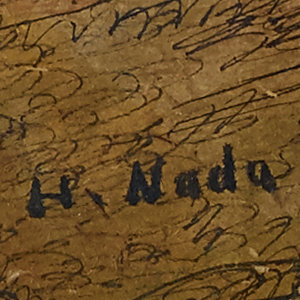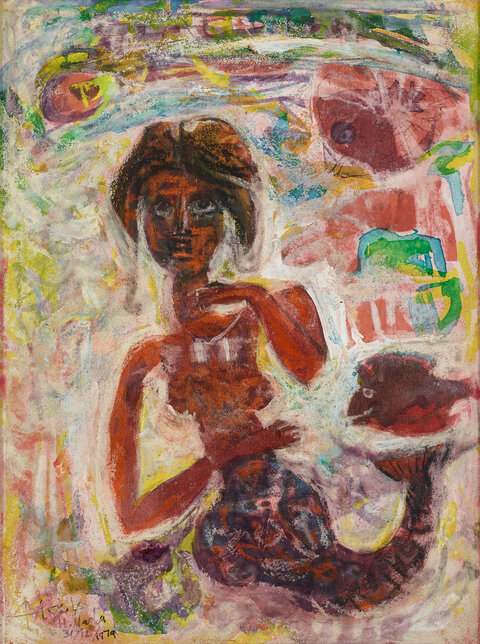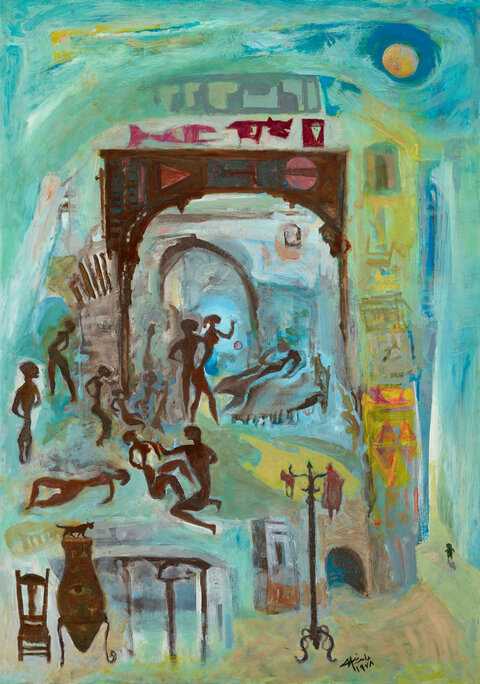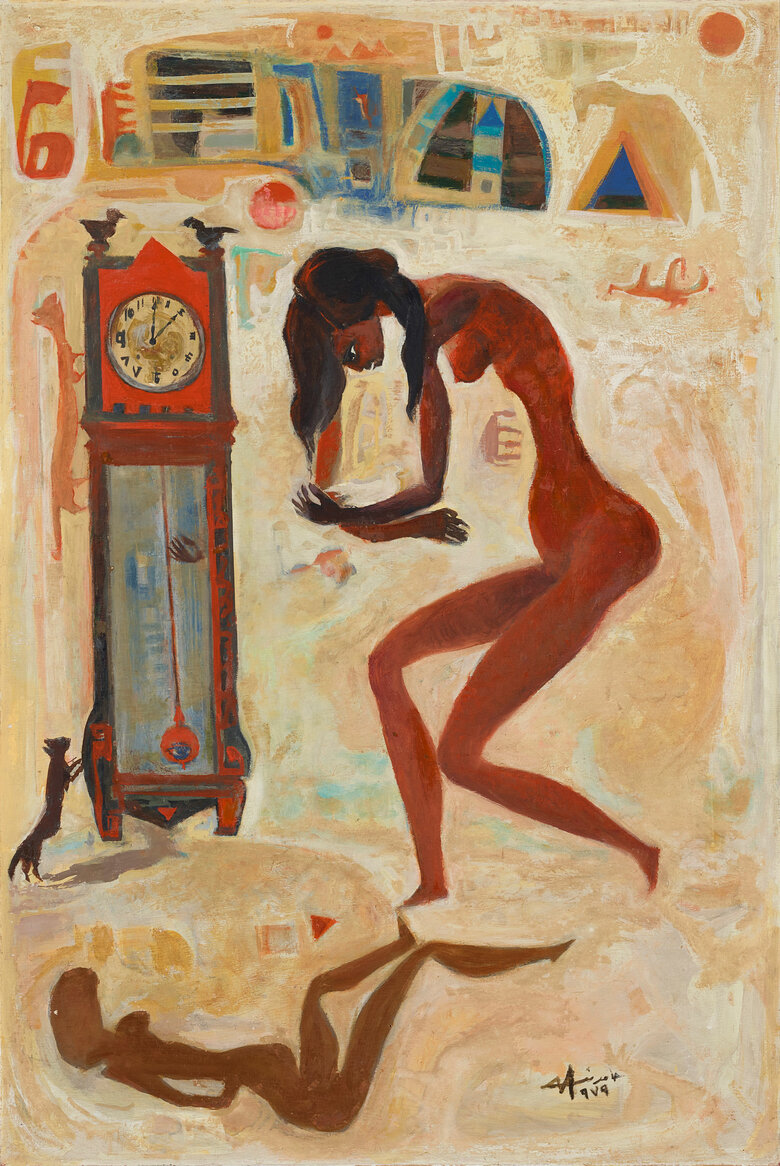Born in 1924 in the district of Al-Qa’la in Cairo, Hamed Nada grew up in the popular neighborhood of Sayeda Zeinab, known for the same named mosque, dedicated to the Prophet Muhammad’s daughter,...


HAMED NADA, Egypt (1924 - 1990)
Bio
Written by ARTHUR DEBSI
Born in 1924 in the district of Al-Qa’la in Cairo, Hamed Nada grew up in the popular neighborhood of Sayeda Zeinab, known for the same named mosque, dedicated to the Prophet Muhammad’s daughter, Zeinab; and for which, Nada’s father was responsible for the administration. At that time, the influence of the organization called the Muslim Brotherhood (Al-Ikhwan al-Muslimin) widespread in Egypt, providing social services to the poor. Instituted in 1928 by the Egyptian political, and religious Hassan al-Banna (1906-1949), the organization has promoted to this date, the application of the Islamic law in Muslim modern society. Furthermore, Al-Banna established a committee of the Muslim Brotherhood in Sayeda Zeinab neighborhood[1]. Nada consequently lived in this religious environment, but quickly showed an interest in art, philosophy, and psychology, when he enrolled at the Secondary School of Hilmiyya. In the early 1940s, the painter, and art educator Hussein Youssef Amin (1904-1984) taught drawing in this establishment, and noticed the talent of some young pupils to which, he proposed to offer a curriculum. These pupils, including Hamed Nada, Abdel Hadi El-Gazzar (1925-1966), Samir Rafi (1926-2004), and Mahmoud Khalil (1929-1955), used to gather, and trained at their teacher’s villa, located next to the Pyramids. The pedagogical approach of Amin tended to discard the academic art methods, and integrated new techniques based on freedom expression, and self-development[2]. In 1948, Hamed Nada enrolled at the Faculty of Fine Arts in Cairo, and was mentored by the great painters Ahmed Sabry (1889-1955), and Youssef Kamel (1891-1971). While he was student, Nada also worked as a critic, and illustrator for the literary review Al-Thaqafa (The Culture). Graduated in 1951, he started teaching at a primary school, and then completed his studies at the Luxor Atelier in 1956, which was an artists’ residency established by the artist Mohamed Naghi (1888-1965) in the village of Gourna, to promote the ancient Egyptian art. Over one year, he studied the mural paintings, and bas-reliefs seen in the temples of the Valley of Thebes, before coming back to Cairo in 1957. The same year, he went to Alexandria, where he was appointed teacher of painting at the Faculty of Fine Arts, which was newly founded by the sculptor Ahmad Osman (1907-1970). In 1960, Nada traveled on a scholarship to Spain, where he again studied mural painting at the Real Academia de Bellas Artes de San Fernando in Madrid. The following year, he returned to Egypt, and worked as a teacher at the School of Fine Arts in Cairo, and would be appointed head of the department of painting in 1977.
In 1946, Hamed Nada co-founded the Contemporary Art Group (Jama’at al-Fann al-Mu’asir) with Hussein Youssef Amin (1904-1984), Abdel Hadi El-Gazzar (1925-1966), Samir Rafi (1926-2004), and Mahmoud Khalil (1929-1955). Successors of the Art and Liberty group, these artists firstly aimed to detach their productions from academism, especially promoted by the School of Fine Arts in Cairo, and the Westernized Egyptian artistic, and cultural circles; as they announced in their second declaration in 1948: ‘Classical art tended toward the beautification of nature, due to the particular circumstances from which it emerged, whereas contemporary art heads in a more literary, philosophical, scientific direction’[3]. They sought for the relationship between art, and thought. Secondly, the subjects of the representation changed from a European colonial art to a painting reflecting the social realities of Egypt’s population, without conveying a nationalist idea. For the group, it was important to understand the different, and multiple facets of their environment in order to create an authentic Egyptian art.
Hamed Nada experienced the life in Sayeda Zeinab, inhabited by the middle, and working-classes of the Egyptian capital city, like the painter Abdel Hadi El-Gazzar (1925-1966) did. The district also accommodated a population, living in extreme precarious conditions. In his early works, such as Pain (1951), part of the Dalloul Art Foundation’s collection, Nada depicted a dark scene, where a woman sitting on the floor, holds the body of man, dying in her arms. He represented a home interior with very basic furniture, emphasizing the poverty in which, these underprivileged characters live. Yet, the painter functioned on a psychological level in his creative process, as he stated: ‘Growing up made me develop a more inquisitive outlook. I became interested in psychology and read about psychoanalysis, and the artworks of Freud and Adler dealing with disguised pathological behavior. I became aware of the tragic conflict between the inner and outer lives (…)’[4]. He doesn’t only illustrate an anecdotal scene, but conveyed deep emotions like sadness, and empathy, that he shared with the viewer. Besides, the painting becomes symbolic with the use of the oil lamp, and the empty chair, which are recurrent in Nada’s artworks, materializing the human soul.
In the oeuvre of the artist, and more generally the works of artists from the Contemporary Art Group, symbolism is omnipresent. They used a wide range of motifs, which belong to the popular Egyptian visual culture, and recall an idea, or a theory, that the public at large is able understand. Again, the childhood of Hamed Nada in Sayeda Zeinab, was a significant source of inspiration. The area was known to attract fortune-tellers, and where some rituals, and sessions of exorcism were practiced. Additionally, many festivals with magicians, acrobats, and religious celebrations, especially the moulid – commemoration of the Prophet Muhammad’s birth –, were held. This vibrant, and enchanting environment highly nourished the imagery of Nada, as he remembered: ‘My father used to speak to me a lot about insane saints and dervishes. So, like everybody else, I would kiss their hands, seeking their blessings and wanting to satisfy God and the jinn as well’[5]. The iconography of Hamed Nada’s artworks reveals an important part of his attachment to folk culture, magic and mythology. In the painting Little Mermaid (1979), also part of the Dalloul Art Foundation’s collection, he portrayed with a palette of warm colors a mermaid, who stands in the middle of the composition, and surrounded by fish. The myth of the mermaid is commonly inherent to the Western culture, but this half-woman half-fish creature does belong to the Arab-Islamic culture too. As a matter of fact, in the famous, and old collection of tales One Thousand and One Nights (Alf Laylah wa-Laylah), Julnar is a Sea-born creature, who was gifted as a slave girl to King Shahriman[6]. Here, Hamed Nada demonstrated his fascination for tales, that he used to discuss the nature, and enjoy the imaginary world, in which the reader, or the listener are embarked. In a surrealist manner, he progressively integrated in his pieces some elements such as cats, keys, and clocks, which superimpose on top of each other.
Hamed Nada was captivated by the drawings produced by his pupils, during his time as a teacher at a primary school. These drawings looked like mural painting. This marked a shift in his oeuvre as of the 1970s, when he started painting with a strong affiliation to the Ancient Egyptian, and Nubian artistic heritage. The artworks became full of bright colors, and the sad themes turned into dynamic, and joyful scenes. In the work Untitled (1987), part of DAF’s collection, Nada revealed a scene, where some people are dancing to the rhythm of the music, played by two hybrid creatures – half men and half-animal. He gave the composition a rough appearance, and somehow makes it look like a mural painting, through the ochre color of the bodies, and the lack of perspective. The entire work is a clear celebration of the Egyptian culture from the Pharaonic times, in particular, with the orange pyramid in the background, and in the stylization of the motifs, which resemble hieroglyphs. However, their treatment is different from the traditional form in the sense that the artist insisted on their mystic power, rather than their literal meanings.
The formation of the Contemporary Art Group marked a pivotal moment in the history of modern Egyptian art in the 19th, as the Lebanese writer, and art critic Aimé Azar wrote in the book entitled La Peinture moderne en Égypte, from 1961: ‘Egyptian painting began with a miracle around 1946’[7]. The founding members of the movement preferred to choose the term of ‘contemporary’ (mu’asir) instead of using ‘modernity’ (hadatha), because it doesn’t mean a break with the past[8]. Through a personal creation, Hamed Nada succeeded in making his paintings contemporary, by establishing a connection between he, the artist, and his audience.
Hamed Nada passed away in 1990.
Notes
[1] Kane, Patrick. "Art Education and the Emergence of Radical Art Movements in Egypt: The Surrealists and the Contemporary Arts Group, 1938-1951." The Journal of Aesthetic Education 44, no. 4 (2010): 95-119. Accessed September 10, 2020. https://www.jstor.org/stable/10.5406/jaesteduc.44.4.0095 [P.104]
[2] Boutros, Nabil, Maria Golia, and Edouard Al Kharrat. Contemporary Art Group, Cairo 1946. [Exhbition catalogue, ‘Art Dubai Modern’. Dubai, Art Dubai, March 22nd – March 24th 2018]. Cairo, Egypt: Karim Francis Galley, 2018.
[3] Unsigned text, from transcription in Husayn Yusuf Amin, ‘Abd al-Hadi al-Jazzar: Fannan al-Thawra’, al-Majalla, no.124, 1967. Translation from Arabic by Sarah Dorman in Lenssen, Anneka, A. Rogers, Sarah, and Shabout, Nada. Modern Art in the Arab World, Primary Documents. New York, USA: The Museum of Modern Art, 2018. [P.115]
[4] Hamed Nada quoted in ‘Atiya, Na’im. Al-‘ayn al-‘ashiqa: Khatab ma’a sab’a Rasamin Misriyyin, Cairo, Al-Hay’a al-Missriyya al-‘amma li al-Kitab, 1976. Retrieved in Karnouk, Liliane. Modern Egyptian Art, 1920-2003. Cairo, New York, Egypt, USA: The American University in Cairo Press, 2005. [P. 52-54]
[5] Hamed Nada quoted in Ali, Fatma. Hamed Nada. Cairo, Egypt: General Information organization, 1984. Retrieved in Boutros, Nabil, Maria Golia, and Edouard Al Kharrat. Contemporary Art Group, Cairo 1946. [Exhibition catalogue, ‘Art Dubai Modern’. Dubai, Art Dubai, March 22nd – March 24th 2018]. Cairo, Egypt: Karim Francis Galley, 2018.
[6] F.Burton, Richard. “The Book of the Thousand Nights and A Night,” 2001. http://www.gutenberg.org/files/3441/3441-h/3441-h.htm.
[7] Azar, Aimé. La Peinture moderne en Égypte. 1961 reported in Seggerman, Alex Dika. Modernism on the Nile: Art in Egypt between the Islamic and the Contemporary. Chapel Hill, USA: University of North Carolina Press, 2019.
[8] Radwan, Nadia. Les Modernes D'Egypte: Une Renaissance Des Beaux-Arts Et Des Arts Appliqués (1908-1938). Berne, Switzerland: Peter Lang AG., 2017. [P.266]
Sources
Bardaouil, Sam, and Fellrath, Till. Art Et Liberté, Rupture, War and Surrealism in Egypt (1938-1948. [Exhibition catalogue, ‘Art Et Liberté, Rupture, Guerre Et Surréalisme En Égypte (1938-1948)’. Paris, Centre Georges Pompidou, October 19th 2016 – January 16th 2017]. Paris, France: Skira, 2016.
Boutros, Nabil, Maria Golia, and Edouard Al Kharrat. Contemporary Art Group, Cairo 1946. [Exhibition catalogue, ‘Art Dubai Modern’. Dubai, Art Dubai, March 22nd – March 24th 2018]. Cairo, Egypt: Karim Francis Galley, 2018.
Eigner, Saeb. Art of the Middle-East, Modern and Contemporary Art of the Arab World and Iran. London, UK: Merell Publishers Limited, 2011.
F.Burton, Richard. “The Book of the Thousand Nights and A Night,” 2001. http://www.gutenberg.org/files/3441/3441-h/3441-h.htm.
Kane, Patrick. "Art Education and the Emergence of Radical Art Movements in Egypt: The Surrealists and the Contemporary Arts Group, 1938-1951." The Journal of Aesthetic Education 44, no. 4 (2010): 95-119. Accessed September 10, 2020. https://www.jstor.org/stable/10.5406/jaesteduc.44.4.0095
Karnouk, Liliane. Modern Egyptian Art, 1920-2003. Cairo, New York, Egypt, USA: The American University in Cairo Press, 2005.
Lenssen, Anneka, A. Rogers, Sarah, and Shabout, Nada. Modern Art in the Arab World, Primary Documents. New York, USA: The Museum of Modern Art, 2018.
Radwan, Nadia. Les Modernes D'Egypte: Une Renaissance Des Beaux-Arts Et Des Arts Appliqués (1908-1938). Berne, Switzerland: Peter Lang AG., 2017.
Radwan, and Nadia. “Between Diana and Isis: Egypt's ‘Renaissance’ and the Neo-Pharaonic Style (1920s‒1930s).” Collections Électroniques De L'INHA. Actes De Colloques Et Livres En Ligne De L'Institut National D'histoire De L'art, INHA, 8 Sept. 2017, https://journals.openedition.org/inha/7194.
Seggerman, Alex Dika. Modernism on the Nile: Art in Egypt between the Islamic and the Contemporary. Chapel Hill, USA: University of North Carolina Press, 2019.
Seggerman, Alex. “Interview with a Former Pupil of Hamed Nada.” ArteEast. Accessed September 14, 2020. http://arteeast.org/quarterly/2623-2/.
Shabout, Nada. Modern Arab Art: Formation of Arab Aesthetics. Gainesville, USA: University Press of Florida, 2015.
“Hamed Nada.” Art Talks. Accessed September 14, 2020. http://arttalks.com/artist/hamed-nada/.
The Editors of Encyclopedia Britannica. “Muslim Brotherhood.” Encyclopedia Britannica. Encyclopedia Britannica, inc., September 11, 2020. https://www.britannica.com/topic/Muslim-Brotherhood.
Abaza, Mona, and Sherwet Shafei. Twentieth-Century Egyptian Art: the Private Collection of Sherwet Shafei. Cairo, Egypt: American University in Cairo Press, 2011.
CV
Selected Solo Exhibitions
1953
Professor’s Club, Giza, Egypt
Selected Group Exhibitions
2024
The Collector´s Eye XI, Ubuntu Art Gallery, Cairo, Egypt
2023
Crossroads: A Collector’s Tale, Picasso Art Gallery, Cairo, Egypt
In the Heart of Another Country: The Diasporic Imagination Rises, Sharjah Art Foundation, Sharjah, United Arab Emirates
2022
The Collector’s Eye IX, Ubuntu Art Gallery, Cairo, Egypt
2021
Contemporary African Art from the permanent collection of the Jordan National Gallery of Fine Arts, The Jordan National Gallery of Fine Arts Amman, Jordan
The Collector’s Eye VIII, Ubuntu Art Gallery, Cairo, Egypt
Selected Works from Dimitar Shindov's Collection, National Academy of Art Sofia, Sofia, Bulgaria
2019
From Mokhtar to Gazbia, ArtTalks Egypt, Cairo, Egypt
À la Plume, au pinceau, au crayon: Dessins du monde arabe, Institut du Monde Arabe, Paris, France
2018
A Century in Flux, Highlights from the Barjeel Art Foundation, Sharjah Art Museum, Sharjah, United Arab Emirates
Art et Liberté, Rupture, War and Surrealism in Egypt (1938-1948), Moderna Museet, Stockholm, Sweden
Art et Liberté, Rupture, War and Surrealism in Egypt (1938-1948), Tate Liverpool, Liverpool, United Kingdom
2017
Art et Liberté, Rupture, War and Surrealism in Egypt (1938-1948), Kunstsammlung Nordrhein-Westfalen,Düsseldorf,Germany
Art et Liberté, Rupture, War and Surrealism in Egypt (1938-1948), Museo Nacional Centro de Arte Reina Sofia, Madrid, Spain
2016
Beloved Bodies, Barjeel Art Foundation, Sharjah, United Arab Emirates
The Egyptian Surrealists (1938-1965), Palace of the Arts, Cairo, Egypt
Art et Liberté, Rupture, guerre et surréalisme en Égypte (1938-1948), Centre Pompidou, Paris, France
2014
Sky Over the East, Emirates Palace, Abu Dhabi, United Arab Emirates
Mathaf Collection Summary, Part 1, Mathaf: Arab Museum of Modern Art, Doha, Qatar
2010
Remembered Late Artist Hussein Youssef Amin, Founder of the Group of Contemporary Art, Al-Masar Gallery for Contemporary Art, Cairo, Egypt
2002
Private Collection, Safar Khan Gallery, Cairo, Egypt
2001
Private Collection, Safar Khan Gallery, Cairo, Egypt
1961
The 4th Alexandria Biennial, Alexandria, Egypt
1959
The 3rd Alexandria Biennial, Alexandria, Egypt
1957
The 2nd Alexandria Biennial, Alexandria, Egypt
1955
The 1st Alexandria Biennial, Alexandria, Egypt
1953
The 3rd São Paulo Biennial, São Paulo, Brazil
1952
The 26th Venice Biennial, Venice, Italy
1951
Third exhibition of the Contemporary Art Group, Bureau des Avocats, Cairo, Egypt
1949
Égypte-France, Musée des Arts Décoratifs, Pavillon Marsan, Paris, France
Exhibition at Y.M.C.A, Cairo, Egypt
1948
Exposition de l’Art Contemporain, Service de la Jeunesse, Cairo, Egypt
1946
Foyer d’Art du Lycée Français, Cairo, Egypt
Selected Awards and Honors
1975
The First Gold Sail Prize of the Kuwait Biennial
1959
The First Prize of the Salon du Caire
The Second Prize of the Alexandria Biennial
Affiliations and Memberships
1977
Honorary member of the Mediterranean Culture Centre of Barcelona, Spain
1946
The Contemporary Art Group
Collections
H.E.Sh. Hassan M. Al Thani collection, Doha, Qatar
Institut du Monde Arabe, Paris, France
Mathaf: Arab Museum of Modern Art, Doha, Qatar
May Moein Zeid & Adel Youssry Khedr collection, Cairo, Egypt
Sherwet Shafei collection, Cairo, Egypt
The Barjeel Art Foundation, Sharjah, United Arab Emirates
The Jordan National Gallery of Fine Arts, Amman, Jordan
The Museum of Fine Arts, Alexandria, Egypt
The Museum of Modern Egyptian Art, Cairo, Egypt
The Ramzi and Saeda Dalloul Art Foundation, Beirut, Lebanon
Press
ArteEast Interview with a Former Pupil of Hamed Nada.pdf
طباعة الاخبار-حامد ندا.. فنان للرمق الأخير.. عاش للرسم ومات به.pdf
حامد ندا نجم الفن المعاصر.. فى كتاب للناقد صبحى الشارونى - الأهرام اليومي.pdf
حامد ندا... العائد بشخوصه السوريالية.pdf
Al Arab.pdf
elaph.pdf
الحياة - أعمال حامد ندا تخاطب السمع كما البصر.pdf
HamedNada_An east-west confection_The Economist_Press.pdf
Hamed Nada ,,, the painter of music & dance Karim Badr Pulse LinkedIn.pdf
حامد ندا.. رائد «السريالية الشعبية» ومراحل إبداعاته الثلاث - الأهرام اليومي.pdf
مصرس _ كيف نتذوق أعمال الفنان حامد ندا ؟.pdf
حامد ندا رائد السريالية ... — رقيم.pdf
Hamed Nada_press release_by Farouk Youssif_AlArab_Press.pdf
HamedNada_Feb2009_CairoNewspaper_Press.pdf
100 لوحة مصرية.. _المنتصر _ لـ الفنان حامد ندا الاحتفال بحرب 1973 - اليوم السابع.pdf
فى ذكرى ميلاده الـ 96.. حامد ندا «عاشق الخرافة» ورائد سريالية الفن التشيكلي _ بوابة أخبار اليوم الإلكترونية.pdf
لوحات حامد ندا .. تجسيم وتسطيح وعناصر سيريالية _ أحمد فضل شبلول _ MEO.pdf
HAMED NADA Artwork
Become a Member
Join us in our endless discovery of modern and contemporary Arab art
Become a Member
Get updates from DAF
Follow Artists
Save your favourite Artworks
Share your perspectives on Artworks
Be part of our community
It's Free!
We value your privacy
TermsCookiesPrivacy Policies
Become a Member
Get updates from DAF
Follow Artists
Save your favourite Artworks
Share your perspectives on Artworks
Be part of our community
It's Free!
We value your privacy
TermsCookiesPrivacy Policies
Become a Member
Get updates from DAF
Follow Artists
Save your favourite Artworks
Share your perspectives on Artworks
Be part of our community
It's Free!
We value your privacy
TermsCookiesPrivacy Policies
Welcome to the Dalloul Art Foundation
Thank you for joining our community
If you have entered your email to become a member of the Dalloul Art Foundation, please click the button below to confirm your email and agree to our Terms, Cookie & Privacy policies.
We value your privacy, see how
Become a Member
Get updates from DAF
Follow Artists
Save your favourite Artworks
Share your perspectives on Artworks
Be part of our community
It's Free!
We value your privacy
TermsCookiesPrivacy Policies










